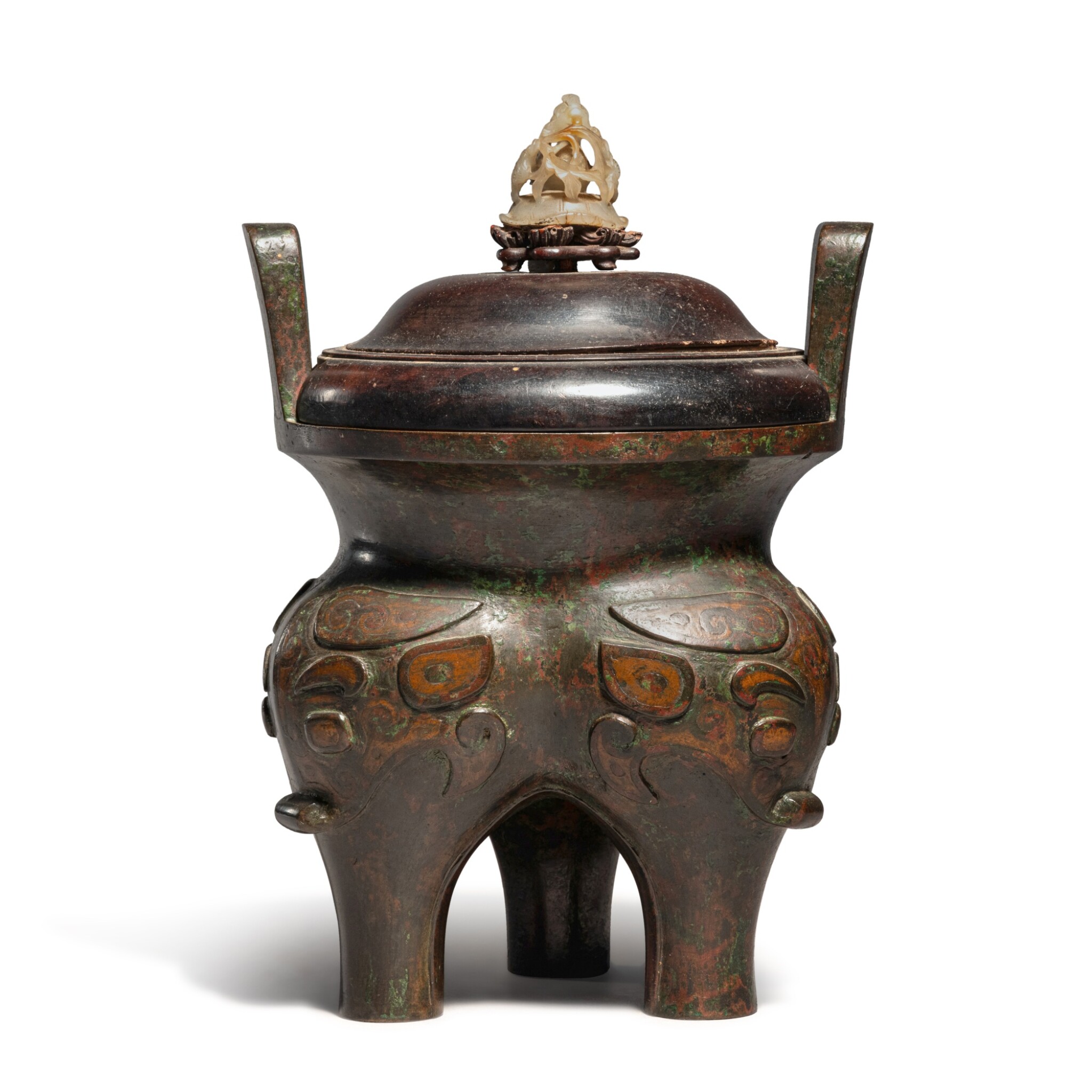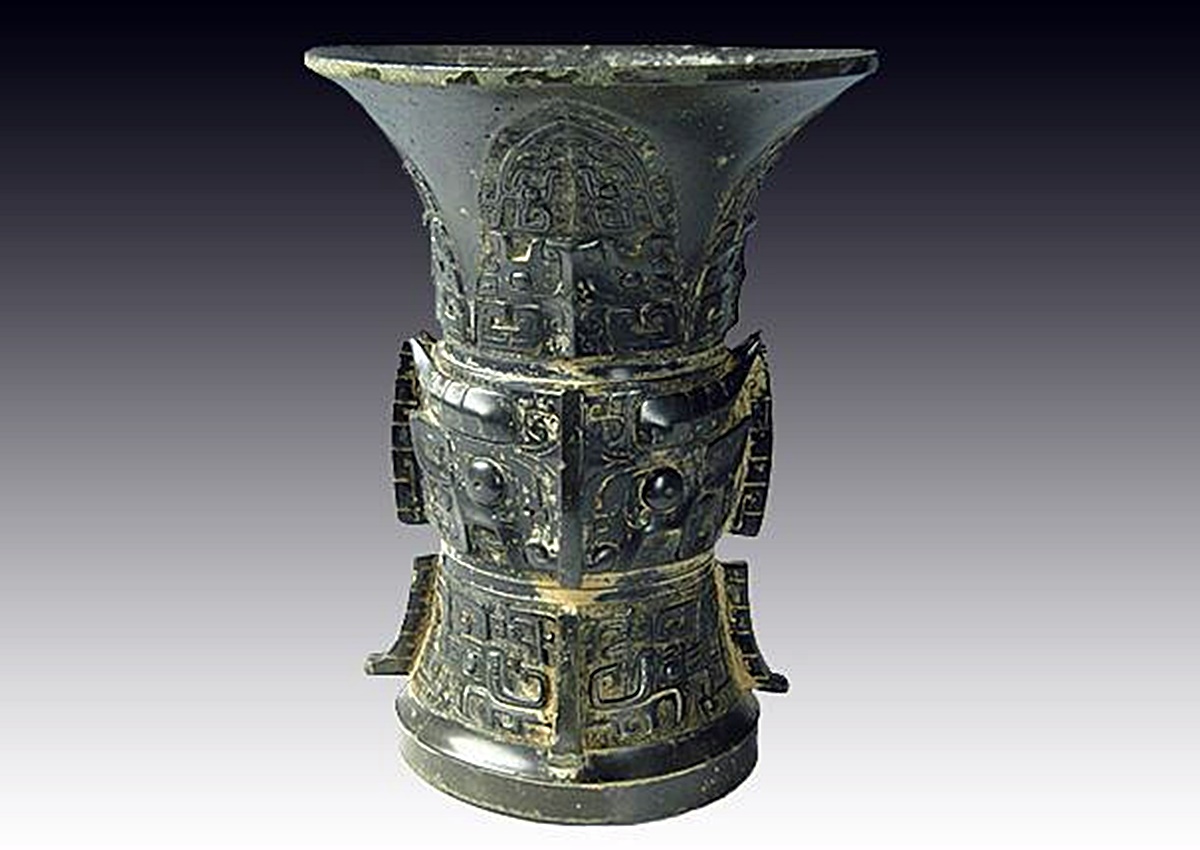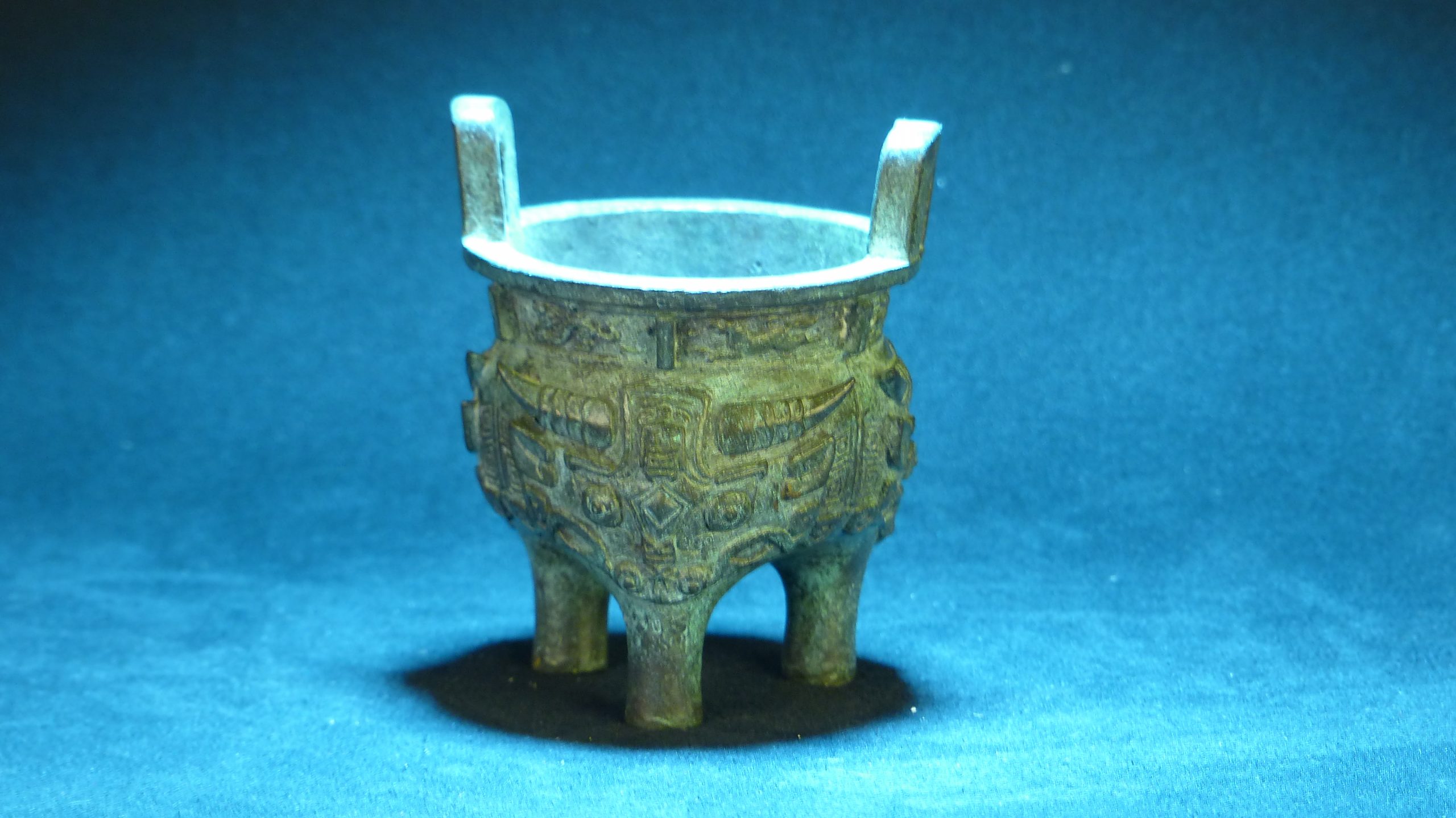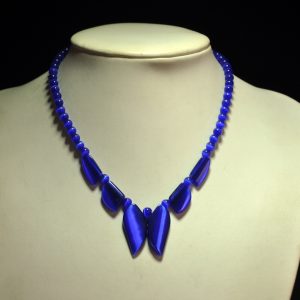Description
青铜 饕餮纹小鬲( lì )鼎
参考:佳士得
現場拍賣 17114
2019年11月5日
中國瓷器及工藝精品
拍品 2 晚商 青銅鬲鼎
A BRONZE RITUAL TRIPOD FOOD VESSEL, DING
PROPERTY FROM AN IMPORTANT PRIVATE EUROPEAN COLLECTION
LATE SHANG DYNASTY, 12TH-11TH CENTURY BC








成交價 英鎊 250,000
估價 英鎊 30,000 – 英鎊 50,000
晚商 青銅鼎
LATE SHANG DYNASTY, 12TH-11TH CENTURY BC
8 1/8 in. (20.7 cm.) high
來源
巴黎古董商盧芹齋(1880-1957)(傳)
歐洲重要私人珍藏,於1998年前所購
狀況報告
拍品專文
青銅鬲鼎 鎏金帶大型浮雕的古青銅爐蓋,每個葫蘆體上都刻有古代青銅器中最受歡迎的濕垂紋面。藝術家受到商代晚期和西周早期的啟發而創作。R. Bagley 在《Shang Ritual Bronzes in the Arthur M. Sackler Collections》一書中,描述了兩個非常相似的鎏金蓋,來自Sackler Collection,其中每個濕垂紋面的兩側還有一對下降的龍。他在對其中一個Sackler蓋的描述中,编号93,描绘了七个相关的蓋,以支持他的观点,即“在晚期殷墟时期,该类型在广泛的地理范围内有所分布”,并延续到西周早期。另外两个蓋來自一個貴族家族的歐洲收藏,於2019年3月22日在紐約佳士得拍賣,拍品编号為1502和1507。
Liding with large, relief-cast taotie masks on each lobe of the body represent one of the most popular vessel types in the late Shang and early Western Zhou periods. Two very similar liding, from the Sackler Collection, cast with an additional pair of decsending dragons flanking each taotie mask, are illustrated by R. Bagley in Shang Ritual Bronzes in the Arthur M. Sackler Collections, Washington, D. C., 1987, pp. 486-91, nos. 93 and 94. In his entry for the one of the Sackler liding, no. 93, Bagley illustrates seven related liding to support his assertion that there was a “wide geographic distribution of the type in late Anyang times”, with a continuation into the early Western Zhou period. Another two liding from a distinguished European collection, were sold at Chrsitie’s New York, 22 March 2019, lot 1502 and 1507.
狀況報告
– 從口緣向身體方向有一處修復區域,約延伸約5厘米。
– 根據X光,有一條從口緣向身體方向延伸的裂縫,長約5厘米。
– 在器物的下部(在濕垂紋面之間)還有一個約4厘米的小修復區域。
– 如有需要,可以向本部門索取X光圖像。
参考:苏富比
CHINA / 5000 YEARS
PROPERTY OF AN IMPORTANT PRIVATE COLLECTION, CALIFORNIA
December 1, 08:05 AM PST
Lot 694. An archaistic copper-inlaid bronze tripod censer (Ding), Ming dynasty
明 銅錯銅饕餮紋冲天耳鼎式爐





Estimate 2,000 – 3,000 USD
Lot Sold 37,800 USD
An archaistic copper-inlaid bronze tripod censer (Ding)
Ming dynasty
明 銅錯銅饕餮紋冲天耳鼎式爐
the inner rim inscribed with a pictogram, wood cover and stand (3)
Width across handles 6½ in., 16.7 cm
Condition Report
Overall in good condition with minor expected surface wear and some casting imperfections on the inner edges of the handles.
参考:青铜器,西周兽面纹食尊
兽面纹又称饕餮纹,多用在商周时期青铜器纹饰描述中,指由眼、眉、角、鼻、口、身及足等部位组成的以正面形态表现的兽形图案,突出表现兽的面部。

上世纪的青铜器纹饰描述多用饕餮纹一词,皆为约定俗称的称谓。饕餮纹一词最早出现于宋代《宣和博古图》中,依据《吕氏春秋》记载的“周鼎著饕餮,有首无身,食人未咽,害其及身”。

然从现有的商周时期青铜器纹饰来看,有首无身的饕餮纹仅为一小部分,而更多的则有首有身。如仍用饕餮纹来形容这些纹饰,确不符合古人对饕餮有首无身的描述。
商人和周人在大量的作为礼器的青铜器上使用这种图案,绝对不是为了表示贪财、贪食(饕餮,贪财为饕,贪食为餮),而更可能是为了表示威严、权力或身份地位。故现在学者多使用“兽面纹”这一适应面更广、更容易被理解的称谓,以示严谨。

兽面纹在商代和西周早期的青铜器装饰中极为盛行,这段时间内出土的各类青铜器几乎都会用它来作装饰。西周中期及其以后,随着其他题材纹饰的兴起,兽面纹退出了主体纹饰的舞台,仅在耳、鋬或铺首衔环等器物的某个部件装饰中沿用。
参考:佳士得
18 9月 2013| 現場拍賣 3439
重要私人珍藏中國古青銅器
拍品 1103 晚商 青銅饕餮紋鬲鼎
A SUPERBLY CAST BRONZE RITUAL FOOD VESSEL, LI DING
LATE SHANG DYNASTY, 11TH CENTURY BC

成交價 USD 1,563,750
估價 USD 300,000 – USD 500,000
來源
Akron Art Museum, Ohio.
Christie’s New York, 6 November 1980, lot 154.
Eskenazi, London, 1985.
The Bella and P.P. Chiu Collection.
Eskenazi, London, 1993.
出版
Chen Mengjia, Yin Zhou qingtongqi fenlei tulu, Tokyo, 1977, A30, R60.
Noel Barnard and Cheung Kwong-yue, Rubbings and Hand Copies of Bronze Inscriptions in Chinese, Japanese, European and Australasian Collections, Taipei, 1978, no. 1487.
Sun Zhichu, Jiwen zhulu jian mu, Beijing, 1981, no. 0078.
Hayashi Minao, In shu jidai seidoki no kenkyu, vol. 2, Tokyo, 1984, pl. 54.
Eskenazi, Twenty Five Years, London, 1985, no. 4.
Jessica Rawson, The Bella and P.P. Chiu Collection of Ancient Chinese Bronzes, Hong Kong, 1988, no. 7.
展覽
Twenty Five Years, Eskenazi, London, 1985, no. 4.
狀況報告
X-rays of the vessel show the liding to be in good condition overall. There is a minor stress crack and some indentations to the inside of each leg. There are chips or casting irregularities to the bottom of one leg, and the two other legs have what appears to be an added or replaced bottom. There are the expected small chips to the mouth rim and handles and to other extremeties. There is black inlay remaining in some of the intaglio decoration. There is some blue-green encrustation and some light earth adhesions to the upper part of the interior.
拍品專文
The graph cast on the interior of the vessel, possibly reading li, is shaped like a triangularly lobed vessel with handles, and has been described by Zou Heng in Xia Shang Zhou kaoguxue lunwen ji, Beijing, 1980, pp. 345-52, as a clan sign of the Zhou area. J. Rawson, however, points out in The Bella and P.P. Chiu Collection of Ancient Chinese Bronzes, Hong Kong, 1988, p. 42, that the same graph is cast on bronze vessels that “have come from Henan as well as Shaanxi.”
An almost identical li ding is illustrated by J.A. Pope et al., The Freer Chinese Bronzes, Washington, 1967, vol. I, pl. 31 (47.11), where it is dated Shang dynasty, late Anyang, 11th century BC. (Fig. 1) A li ding with similar relief-cast taotie masks on the sides, but with low-relief dragons in the frieze below the rim, and lacking the intaglio decoration on the legs, is illustrated in Shang Ritual Bronzes in the Palace Museum Collection, National Palace Museum, Taipei, 1998, pp. 216-19, no. 24. Other li ding of similar date, and with related taotie masks cast in relief, but with a frieze of cicadas below the rim and also lacking the intaglio decoration on the legs, include one illustrated by R.W. Bagley, Shang Ritual Bronzes in the Arthur M. Sackler Collections, The Arthur M. Sackler Foundation, 1987, pp. 484-85; two illustrated by C. Deydier, Les Bronzes Chinois, Paris, 1980, p. 215, nos. 1 (Museum für Ostasiastiche Kunst, Cologne) and 2 (Ashmolean Museum, Oxford); and the example sold at Christie’s New York, 23 March 2012, lot 1517.
参考:佳士得
29 5月 2012 | 現場拍賣 2915
重要中國瓷器及工藝精品
拍品 4131
A RARE ARCHAIC BRONZE TRIPOD CENSER, DING
商晚期 青銅獸面紋鼎
LATE SHANG DYNASTY (1600-1100 BC)

成交價HKD 4,580,000
估價HKD 2,800,000 – HKD 4,000,000
細節
商晚期 青銅獸面紋鼎
鼎厚唇,深圓腹,立耳,下承三圓柱足。腹部雷紋地上出六扉棱,口沿下飾一道鳥啄龍紋,兩兩相對;龍紋下飾大獸面紋,有眉有角,雙眼圓凸。
此器紋飾尤為突出,共分三個層次,獸紋眼珠和扉棱為最突出的上層,主紋飾為第二層,地紋為底層。三層紋飾互相呼應,極富立體感,反映出工匠高超的水平和細密的心思。此器線條清晰流暢,保存完好,甚為珍貴。類似紋飾可參照上海博物館的史鼎,惟該器頸腹的扉棱各自為兩節。
獸面紋是青銅器上常見的紋飾,盛行於商周時期。直到宋朝宣和年間著作《博古圖錄》才開始採用饕餮紋這個名稱,具驅鬼避邪、勇敢、公正等象徵意義。杜預著《左氏傳》曰:「貪財為饕,貪食為餮。」傳說中饕餮是一種貪食的惡獸,也比喻貪婪、兇惡的人。《呂氏春秋.先識》曰:「周鼎著饕餮,有首無身,食人未咽,害及其身,以言報更也。」
鼎原為炊器,至商周在禮制中被賦予特殊的意義,成為象徵權威的重要禮器之一。根據古代文獻記載,不同等級的人們使用鼎的數目和大小各不同,何休著《公羊.桓公二年傳》記載:「天子九鼎,諸侯七,大夫五,元士三」,這就是按照禮制所定的「列鼎」,可見當時在禮制下人們對權力、等級之分的執著,青銅禮器在當時維護王權的「工具」中扮演了何等重要的角色。隨著禮制的衰落,青銅禮器逐漸失去了這種作用,至清朝成為象徵權威的重要陳設器。
此器著錄於1998年11月16日倫敦佳士得拍賣圖錄,拍品142號。
來源
Previously offered at Christie’s London, 16 November 1998, lot 142
拍品專文
It is interesting to note the depth of the casting with three differentiated layers in relief: the leiwen ground, the taotie masks and the upturned corners of the motifs. The intricate portrayal of the kui dragons is closely related to those traditionally categorised as style V of the Shang dynasty. This type of dragons is comparable to those on the upper and lower bands of a Yu vessel, formerly from the Alfred F. Pillsbury Collection, now in the Minneapolis Institute of Art, and illustrated by M. Loehr, Ritual Vessels of Bronze Age China, Asia House Gallery, 1968, p. 89, no. 36. Compare an example with a similar two-register decoration in the Fitzwilliam Musuem, Cambridge, illustrated by R. Bagley, Shang Ritual Bronzes in the Arther M. Sackler Collections, Washington D.C., 1987, fig. 86.2, where the author mentions another example excavated from Luosha Mangzhang, Henan province, illustrated in Zhongyuan wenwu, 1981.4, pl. 1:2.

![[临渊阁]天地一家春](https://www.antiquekeeper.ca/wp-content/uploads/2023/03/cropped-Asian-Art-Wallpaper-Painting3-6-2.jpg)

























